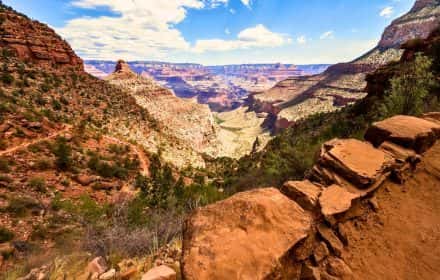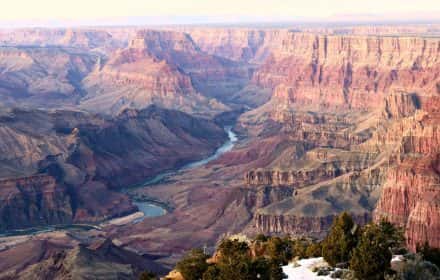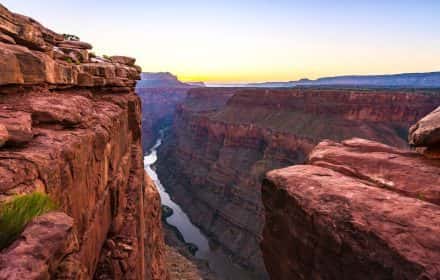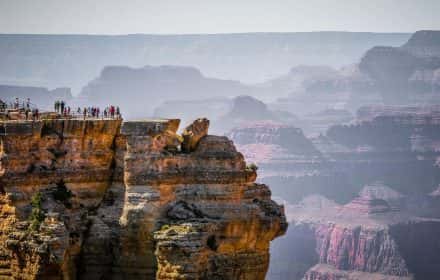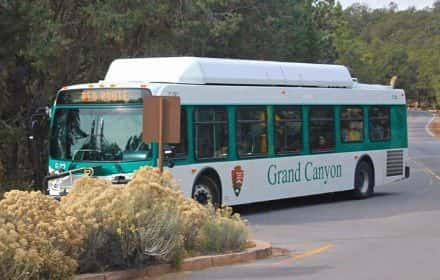This site uses affiliate links, meaning that if you make a purchase through our links, we may earn an affiliate commission.
The Grand Canyon, a geological marvel etched into the heart of Arizona, stands as one of the world’s most awe-inspiring natural wonders. Its vast expanse and breathtaking beauty have drawn adventurers, hikers, and nature enthusiasts from around the globe.
Among the numerous trails that wind through this magnificent chasm, the South Kaibab Trail offers an unparalleled journey into the depths of the canyon.
Venturing along the South Kaibab Trail is not for the faint of heart, but the rewards are immeasurable. From panoramic vistas that seem to stretch into infinity to encounters with the ancient rock layers that tell the story of Earth’s history, this trail promises an extraordinary experience for those willing to take the plunge.
To make the most of your South Kaibab adventure, we have compiled 8 valuable tips that will help you plan, prepare, and embrace this remarkable journey through the Grand Canyon’s depths.
So lace up your hiking boots, grab your backpack, and get ready for an extraordinary adventure along the South Kaibab Trail.
- 1. Overview of South Kaibab Trail in Grand Canyon
- 2. South Kaibab Trail Details - 8 Priceless Tips for Extraordinary Trail Adventure
-
- 2.1. Exploring the Starting Point: Where to Find South Kaibab Trail
- 2.2. Navigating Your Way to the South Kaibab Trailhead
- 2.3. Map of the South Kaibab Trail (Print or Download)
- 2.4. Length and Stopping Points on South Kaibab Trail
- 2.5. Estimating Your South Kaibab Trail Hike Duration
- 2.6. Understanding Elevation Changes on South Kaibab Trail
- 2.7. Step-by-Step Hiking Guide to South Kaibab Trail
- 2.8. Essential Hiking Gear for South Kaibab Trail
- 3. Intrepid Scout's Hiking Tips for an Enjoyable Grand Canyon Adventure
Overview of South Kaibab Trail in Grand Canyon
If you are faced with the challenging decision of choosing just one hike at the Grand Canyon, look no further than the South Kaibab Trail. It stands out as the premier choice for those seeking an extraordinary adventure in this natural wonder.
This iconic trail offers an unforgettable journey through the Grand Canyon’s heart, showcasing sweeping vistas and an awe-inspiring descent along a dramatic ridgeline.
As you begin your hike on the South Kaibab Trail, you will immediately be greeted by breathtaking panoramic views that stretch as far as the eye can see.
The trail’s unique path will allow you to experience the sheer grandeur of the Grand Canyon in all its glory. With every step, you will be captivated by the ever-changing rock formations that tell a story of millions of years of geological history.
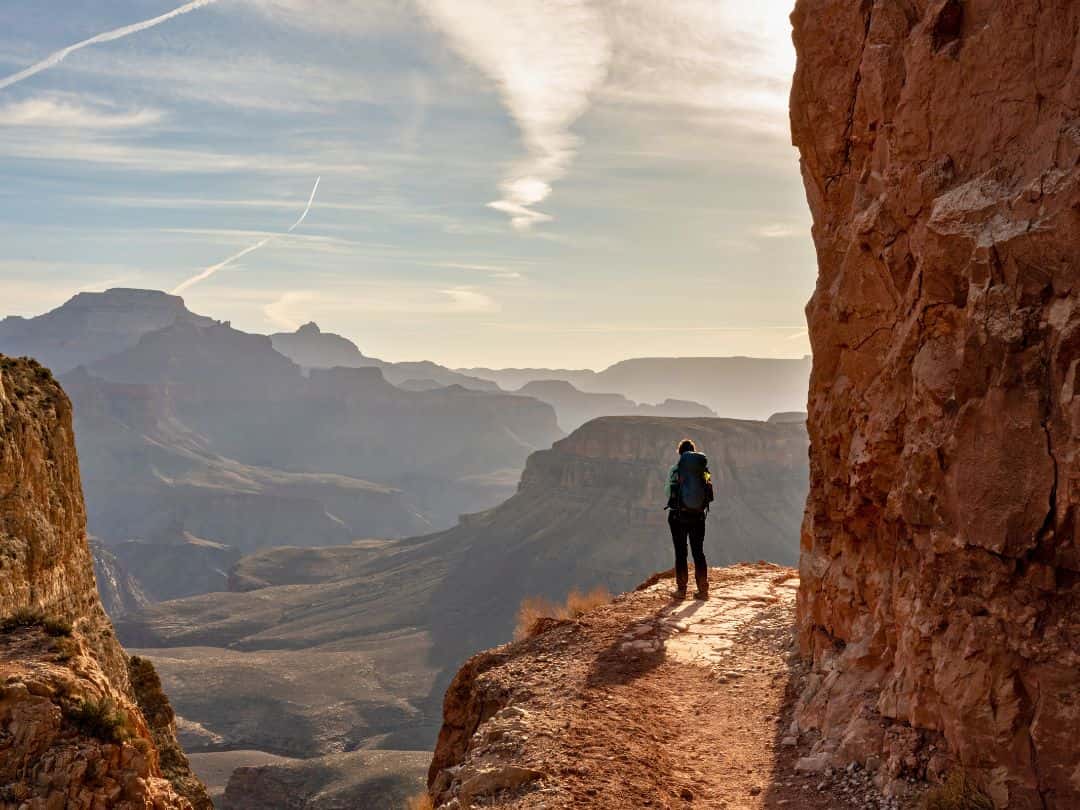
South Kaibab Trail in Grand Canyon
It is a trail that challenges your endurance but rewards your spirit with unparalleled beauty.
As you descend further along the South Kaibab Trail, you will get to venture below the rim of the Grand Canyon, offering a perspective that few get to witness. The sensation of being surrounded by the canyon’s towering walls, painted with vibrant hues, is nothing short of awe-inspiring.
This trail promises an experience that will leave you with memories of the Grand Canyon’s spectacular beauty etched into your heart, making it the ultimate choice for a remarkable adventure in this iconic national park.
South Kaibab Trail Details - 8 Priceless Tips for Extraordinary Trail Adventure
With the South Kaibab Trail’s captivating allure and overall essence now introduced, let’s embark on a deeper exploration.
In this section, we will cover the intricate details that distinguish this trail within the Grand Canyon National Park. From pinpointing the trailhead’s precise location and understanding its length to unraveling the nuances of its distinctive features, this journey aims to furnish you with the practical insights necessary to embark on your very own South Kaibab Trail adventure confidently.
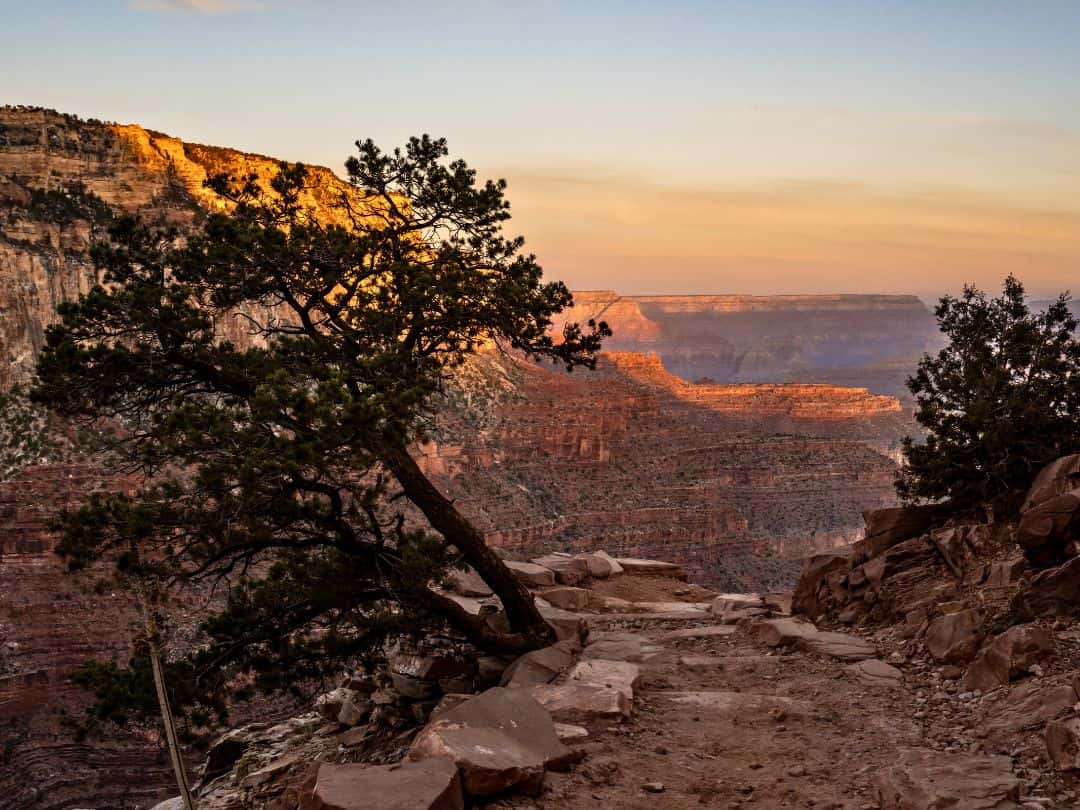
South Kaibab Trail in Grand Canyon
Exploring the Starting Point: Where to Find South Kaibab Trail
The South Kaibab Trail, situated on the South Rim of the Grand Canyon, commences just south of Yaki Point along Yaki Point Road.
This strategic location not only provides a convenient starting point but also grants hikers immediate access to breathtaking views of the Grand Canyon’s splendor.
As you descend along the South Kaibab Trail’s unique ridgeline path, you will be treated to uninterrupted and ever-changing vistas while immersing yourself in the geological history of the Grand Canyon.
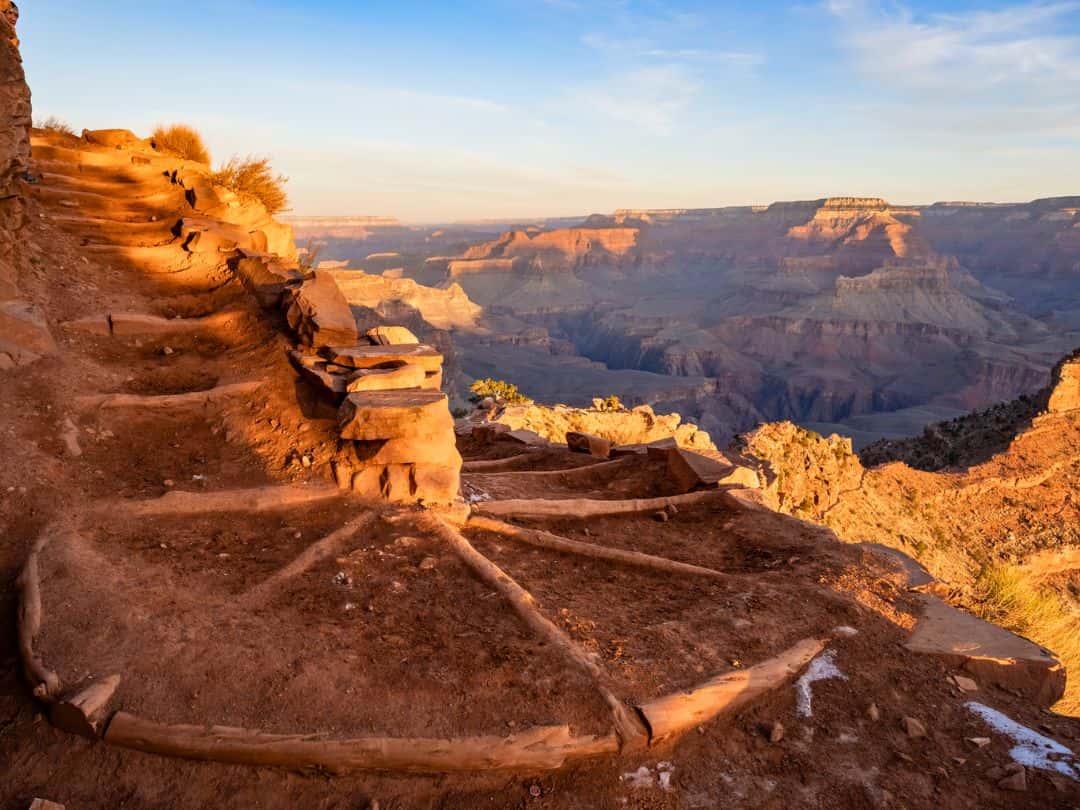
South Kaibab Trail in Grand Canyon
Navigating Your Way to the South Kaibab Trailhead
Access to the South Kaibab Trailhead is exclusively available via shuttle bus, with private vehicles not permitted.
Two shuttle options facilitate your journey to this remarkable trail:
- Orange Route/Kaibab Rim Shuttle Bus:
Begin your adventure by boarding the Orange Route/Kaibab Rim Route Shuttle Bus, ensuring you disembark at the South Kaibab Trailhead.
I typically park at the Grand Canyon Visitor Center and catch the shuttle from there.
The Grand Canyon Visitor Center serves as an excellent starting point, offering a place to orient yourself. Here, you will find a convenient café providing food and beverages and well-maintained restrooms.
If you require a map, simply stop by the ranger station, where you can also check for any pertinent weather advisories.
Most importantly, remember to top up your water supply before setting off, as staying hydrated is crucial for this journey.
- Hikers’ Express Shuttle Bus:
Another compelling option to reach the South Kaibab Trailhead is the Hikers’ Express Shuttle Bus. This early morning bus service presents a spectacular opportunity to witness the sunrise while descending into the canyon—an experience nothing short of phenomenal.
The Hikers’ Express Shuttle Bus initiates its route from the Bright Angel Lodge bus stop on the hour. Subsequent stops include the Backcountry Information Center, the Grand Canyon Visitor Center, and, finally, the South Kaibab Trailhead.
Departure times from Bright Angel Lodge vary by month, ensuring that you can align your journey with your preferred time and the seasonal conditions:
March: 7 am, 8 am, 9 am
April: 6 am, 7 am, 8 am
May: 5 am, 6 am, 7 am
June, July, August: 4 am, 5 am, 6 am
September: 5 am, 6 am, 7 am
October: 6 am, 7 am, 8 am
November: 7 am, 8 am, 9 am
December, January, February: 8 am, 9 am
Choose your preferred shuttle and embark on a journey filled with natural wonders, breathtaking scenery, and the thrill of exploring the Grand Canyon’s South Kaibab Trail.
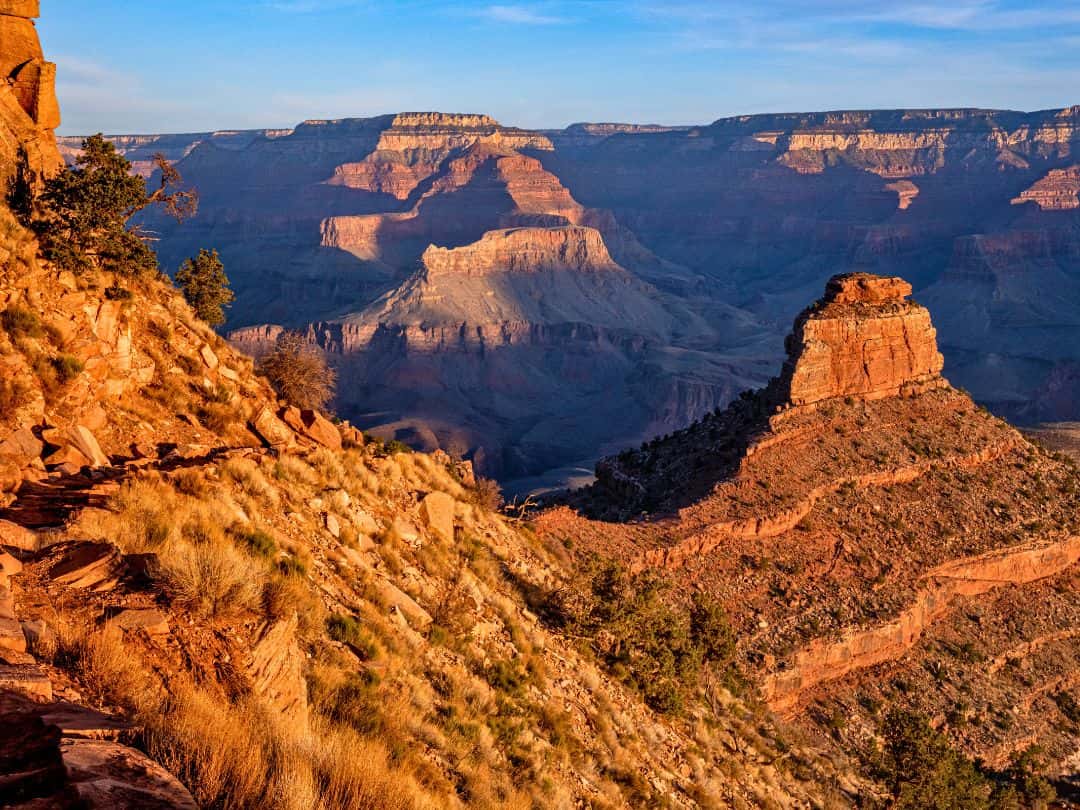
South Kaibab Trail in Grand Canyon
Map of the South Kaibab Trail (Print or Download)
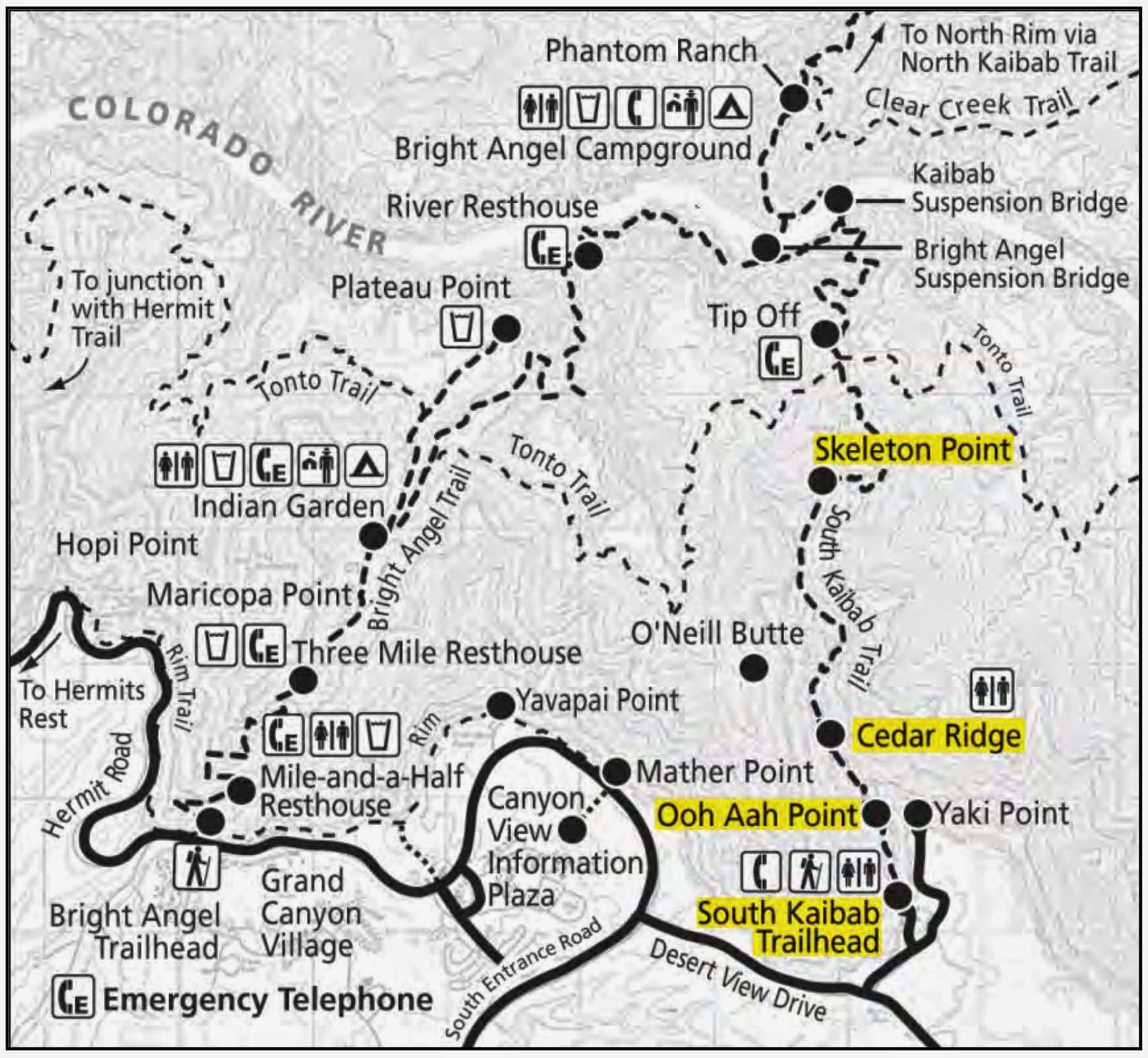
Map of South Kaibab Trail / Image Credit: NPS
Length and Stopping Points on South Kaibab Trail
First and foremost, Grand Canyon Park rangers strongly advise against attempting a round trip from the rim to the river in a single day—an admonition that holds valuable wisdom.
As a result, the majority of hikers opt for more manageable routes, such as the trek to Ooh-Aah Point or Cedar Ridge and back.
For the more adventurous, there’s the option to continue onward to Skeleton Point. Ultimately, the distance you choose to hike is entirely at your discretion.
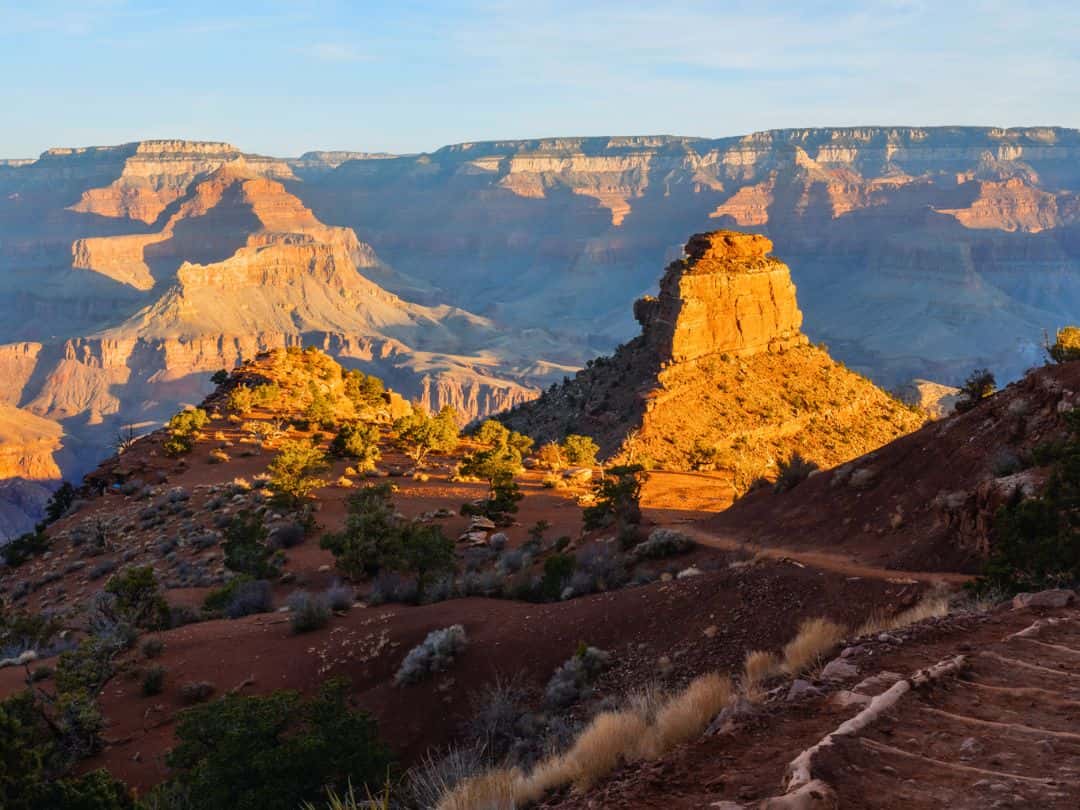
South Kaibab Trail in Grand Canyon
To provide a clear perspective, here are the distances between each of these notable stopping points along the South Kaibab Trail:
- South Kaibab Trailhead to Ooh-Aah Point: 0.9 miles (one-way)
- Ooh-Aah Point to Cedar Ridge: 0.6 miles (one-way)
- Cedar Ridge to Skeleton Point: 1.5 miles (one-way)
These distances serve as valuable reference points as you plan your hike, allowing you to tailor your journey to your preferences and fitness level, ensuring a safe and enjoyable exploration of this remarkable trail in the Grand Canyon.
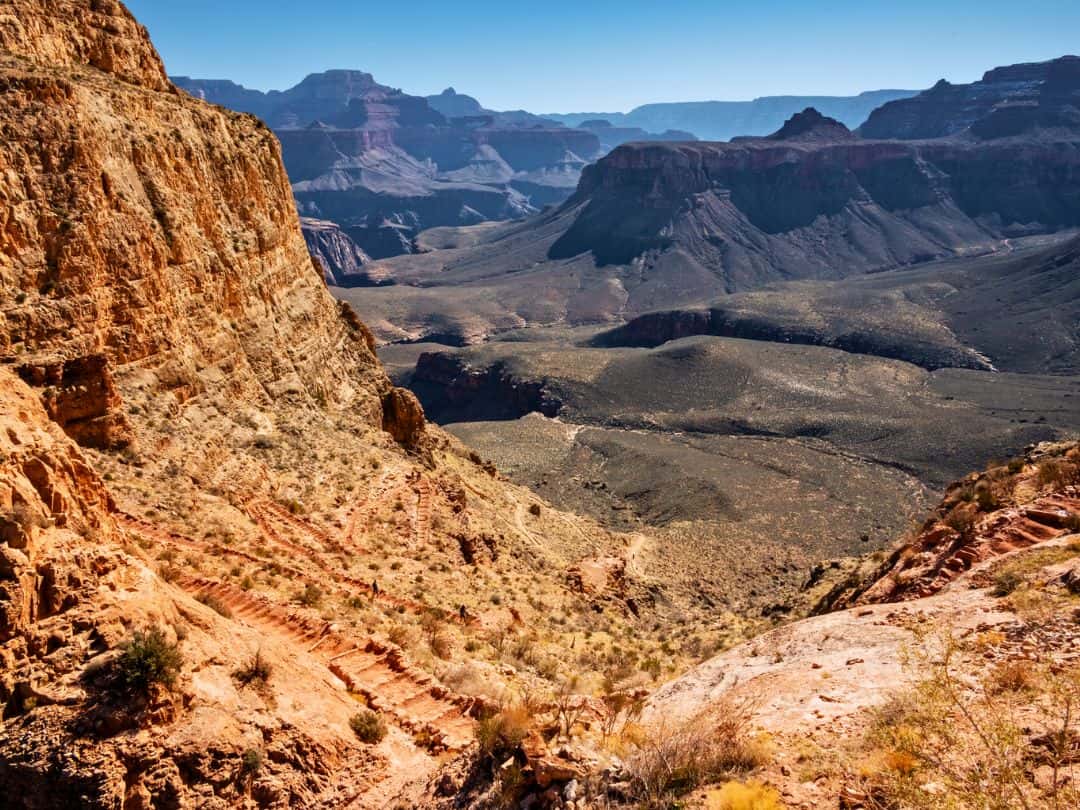
South Kaibab Trail in Grand Canyon
Estimating Your South Kaibab Trail Hike Duration
Typically, the round-trip hike from South Kaibab Trailhead to Cedar Ridge and back spans a duration of 2.5 to 4 hours.
It is crucial to bear in mind that while it may have taken you 2 hours to reach Cedar Ridge, the return journey could require twice that time, as ascending out of the canyon demands additional effort and stamina.
Hence, it is vital to approach this hike with a thoughtful plan that aligns with your own capabilities and pace. Remember, hiking is not a competition; it is an opportunity to savor the breathtaking scenery at your own rhythm.
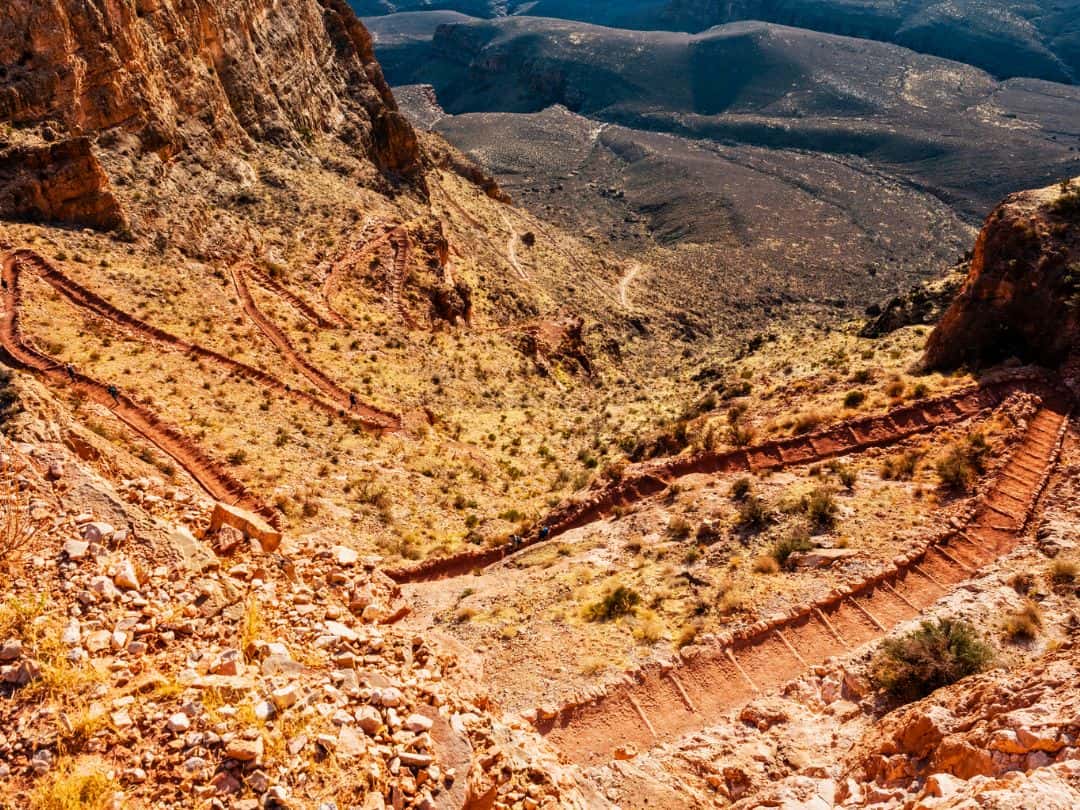
South Kaibab Trail in Grand Canyon
For instance:
- South Kaibab Trailhead to Ooh-Aah Point: The hike from South Kaibab Trailhead to Ooh-Aah Point typically encompasses about 1-2 hours round-trip.
- Cedar Ridge and Back: If you opt to extend your journey to Cedar Ridge and back, allocate approximately 2-4 hours round-trip.
- Skeleton Point and Back: If you embark on the trek to Skeleton Point and return, plan for a duration of approximately 4-6 hours round-trip.
These estimations offer a valuable guideline, allowing you to tailor your hike based on your preferences and ensure you have ample time to immerse yourself in the stunning surroundings of the Grand Canyon.
Understanding Elevation Changes on South Kaibab Trail
Hiking along the South Kaibab Trail offers a departure from the typical uphill treks many of us are accustomed to. Here, you commence your journey with a descent into the Grand Canyon, concluding with an ascent back to the rim.
This reversal in terrain can be somewhat misleading, potentially causing underestimations of the time required for the return ascent.
As a useful rule of thumb, if your descent to Ooh-Aah Point takes approximately 1 hour, it is wise to allocate around 2 hours for the return journey to the rim.
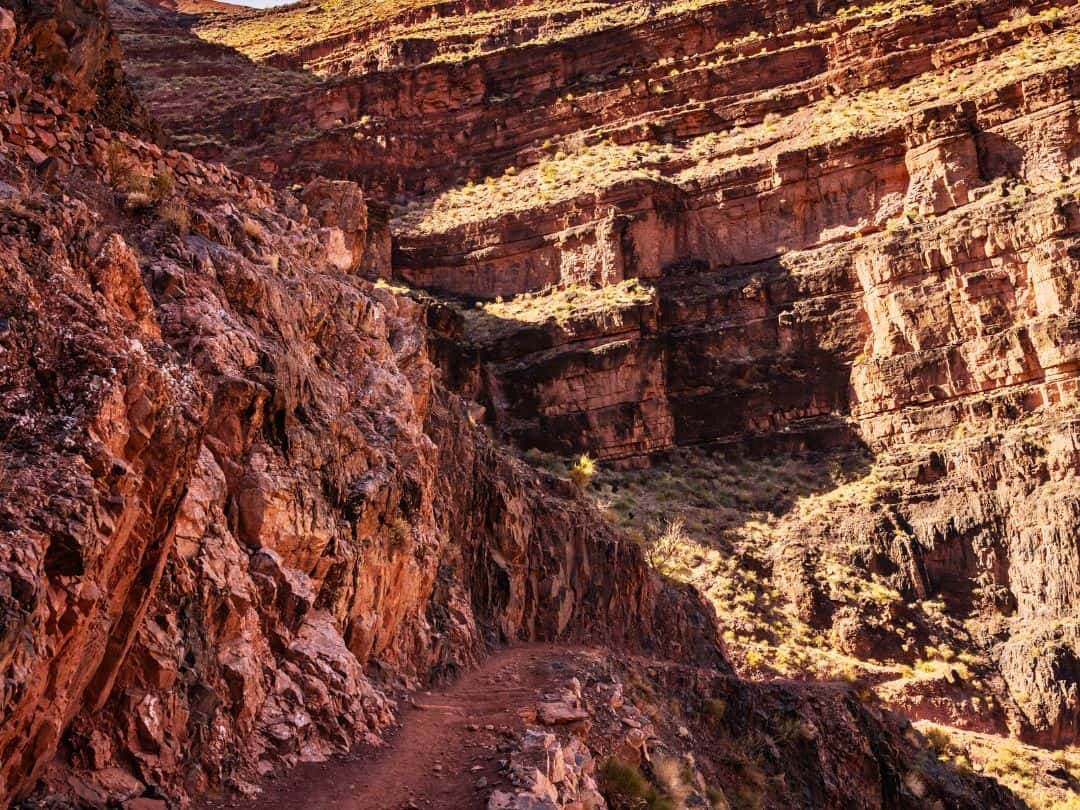
South Kaibab Trail in Grand Canyon
To provide a clearer picture, consider the elevation changes along this trail:
- The South Kaibab Trailhead rests at an elevation of 7,260 feet, with a 600-foot descent to Ooh-Aah Point.
- Ooh-Aah Point lies at an elevation of 6,660 feet, featuring a 540-foot descent to Cedar Ridge.
- Cedar Ridge sits at an elevation of 6,120 feet, and the descent from Cedar Ridge to Skeleton Point descends by 920 feet, with Skeleton Point positioned at an elevation of 5,200 feet.
As you descend into the canyon, it is essential to be mindful of your physical capabilities and plan your journey accordingly.
Keep in mind that once you reach your chosen turnaround point, such as Skeleton Point or any other juncture along the way, you will embark on the return trek back to the trailhead, making prudent planning paramount for a safe and enjoyable adventure in the Grand Canyon.
Step-by-Step Hiking Guide to South Kaibab Trail
In all honesty, the South Kaibab Trail is entirely manageable, provided you adopt a mindful approach: pace yourself, take necessary breaks, enjoy some snacks, and stay well-hydrated!
Here is your step-by-step hiking guide:
- Initial Switchbacks:
The South Kaibab Trail begins with a series of switchbacks that, in some sections, can be quite steep. It is essential to maintain a steady and measured pace, especially during the descent. Rushing can lead to exhaustion and put unnecessary strain on your muscles and joints.
Enjoy the hike at a comfortable rhythm, and remember that it is not a race.
After negotiating these initial switchbacks, the trail levels off and begins a gradual descent. Approximately 0.9 miles in, you will arrive at the aptly named Ooh-Aah Point.
- Ooh-Aah Point:
Ooh-Aah Point, located approximately 0.9 miles into your hike, is a highlight of the trail.
Ooh-Aah Point lives up to its name in every sense! When you first behold the panoramic views, you are bound to find yourself uttering “ooh” in one direction and “aah” in another. The nomenclature is indeed fitting, as the vistas here are nothing short of breathtaking.
PRO TIP: Allocate about 30 minutes to reach Ooh-Aah Point, and plan for roughly 45-60 minutes for your return ascent, which will likely take longer due to the uphill climb.
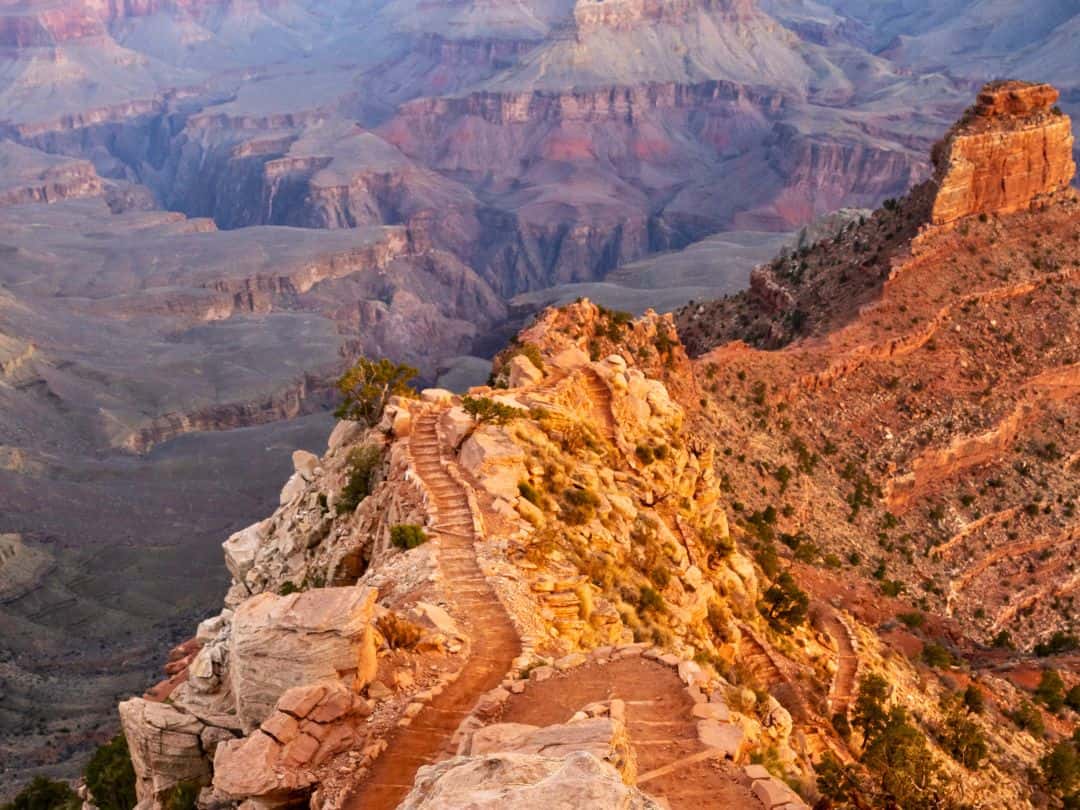
South Kaibab Trail in Grand Canyon
- Cedar Ridge:
If you choose to press on, you will notice the trail hugging an exposed ridgeline. Here, the level of difficulty escalates as the path transforms into a series of steps crafted from logs and dirt.
However, it is worth noting that the views become even more spectacular as you descend further. After covering an additional 0.6 miles, you will arrive at the captivating viewpoint known as Cedar Ridge.
Here, you’ll be treated to sweeping 360-degree views of the Grand Canyon’s magnificent landscape.
Cedar Ridge is an ideal spot to take a break, refuel with snacks and water, and recharge your energy. It is also a suitable turnaround point for hikers who are new to the canyon, as it provides a satisfying taste of the trail’s beauty without the need for an extended journey.
- Consider Skeleton Point:
For those seeking a more challenging adventure, continuing from Cedar Ridge to Skeleton Point is an option. Along this stretch, you will encounter steep switchbacks and a more strenuous terrain.
After approximately 1.5 miles, you will reach Skeleton Point, where you will be rewarded with your first glimpse of the Colorado River—an incredibly memorable sight.
This additional section of the hike offers a deeper immersion into the Grand Canyon’s splendor but should be attempted by experienced hikers who are adequately prepared for the physical demands.
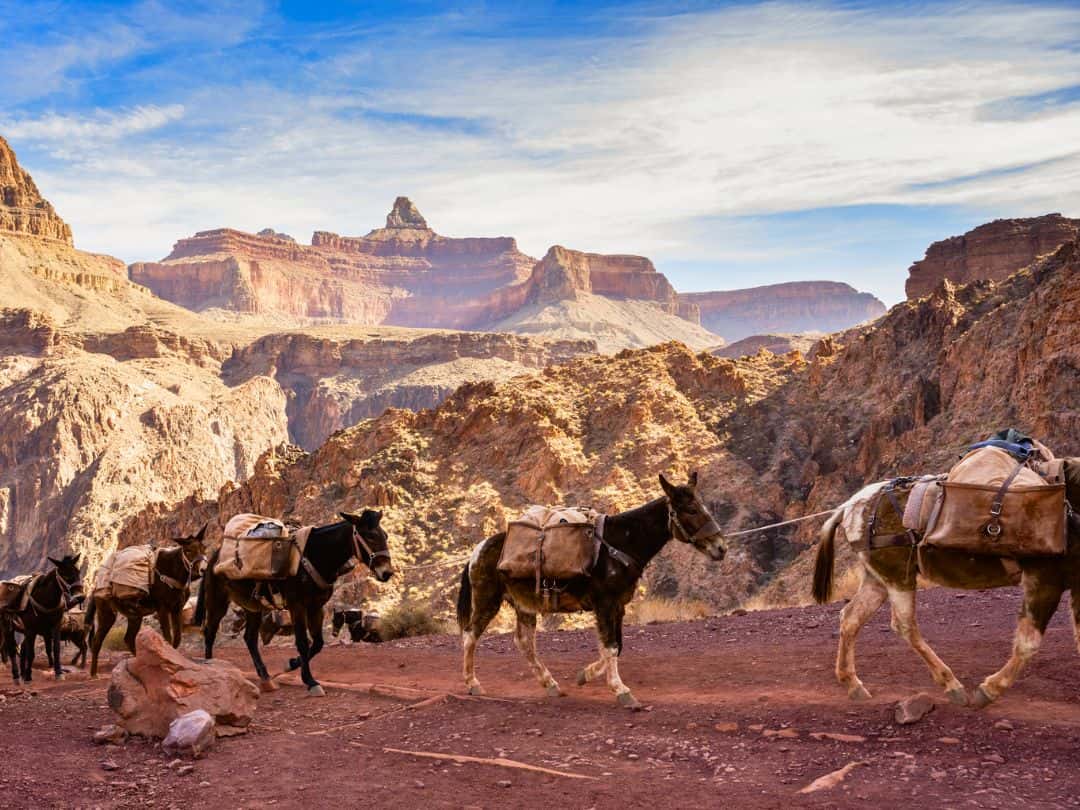
South Kaibab Trail in Grand Canyon
- Hiking Back:
The return journey from your chosen turnaround point to the rim is, without a doubt, a demanding ascent. Hiking out of the canyon requires stamina and careful pacing.
Take your time, pause for rest breaks as needed, replenish your energy with snacks and stay well-hydrated by drinking water regularly.
It is crucial to approach the ascent with patience and a focus on safety, ensuring you have a comfortable and enjoyable experience while making your way back to the rim.
In summary, the South Kaibab Trail offers a range of experiences, from shorter hikes to longer, more challenging treks. Regardless of your chosen route, it is essential to hike thoughtfully, considering your physical capabilities and the demands of the trail.
By pacing yourself, staying well-hydrated, and making smart choices about how far to hike, you can fully immerse yourself in the beauty of the Grand Canyon while ensuring a safe and memorable adventure.
Essential Hiking Gear for South Kaibab Trail
Here is a reminder to make sure to have the basic hiking gear for hiking the South Kaibab Trail:
- Appropriate footwear
Trail shoes are great; hiking boots are even better since they offer more support. You’ll want sturdy, comfortable hiking boots with solid traction. Don’t forget to break in your shoes before bringing them to Grand Teton National Park. Also, do not forget merino wool socks. They will keep your feet dry, and protect you from blisters.
- Plenty of water
Without enough water, your body’s muscles and organs simply cannot perform as well. Consuming too little water will not only make you thirsty but susceptible to hypothermia and altitude sickness. I have been using the Yeti Rumbler 26 oz insulated, stainless steel bottle, and I highly recommend it!
- Food
Food will help keep up energy and morale. I like RXBAR. It is a high-protein bar, gluten-free, and it is super yummy! Make sure to get a variety pack to keep it interesting.
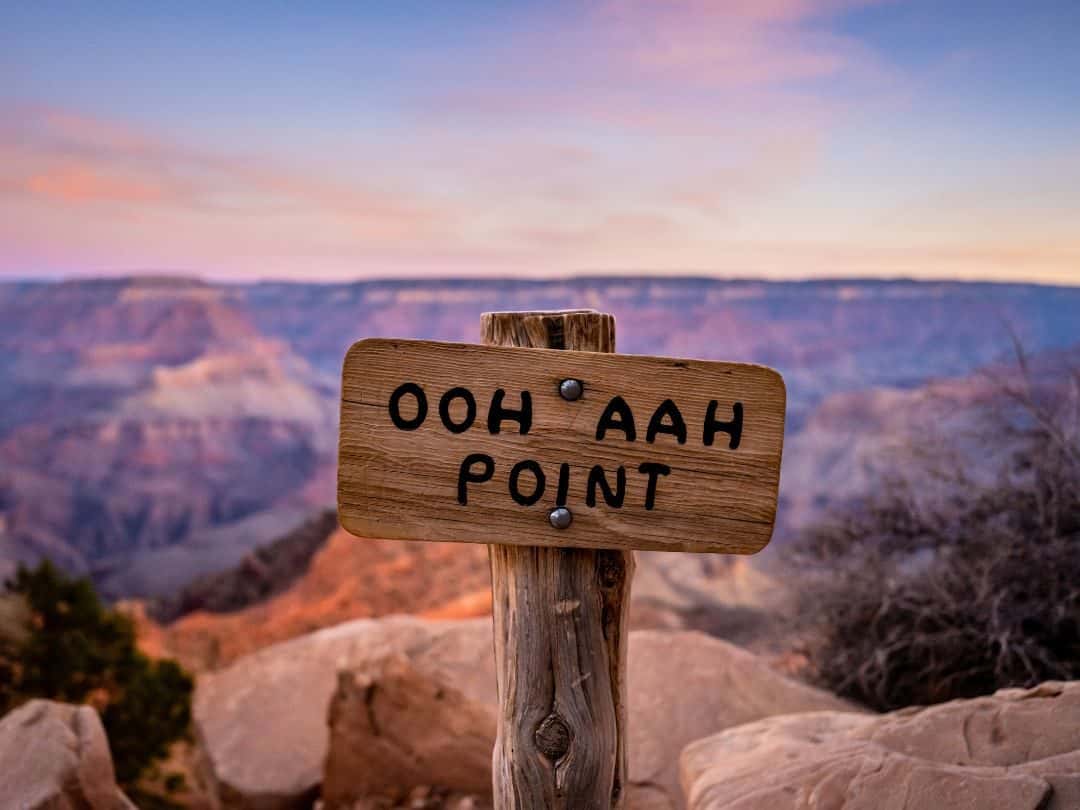
Ooh Aah Point at Sunrise
- Rain gear and extra clothing
The weatherman is not always right. Be prepared for unannounced rain or a cold spell. Dress in layers. It will allow you to adjust to changing weather and activity levels. Two rules: avoid cotton (it keeps moisture close to your skin) and always carry a hat. I have had my North Face Women’s Osito Triclimate Jacket for years, and I love it. Also, I highly recommend these Patagonia moisture-wicking hiking shirts and Patagonia warm fleece pullovers.
- First aid kit
Prepackaged first-aid kits for hikers are available at any outfitter.
- Knife
A knife or even better, a multi-purpose tool is always good to have. These enable you to cut strips of cloth into bandages, remove splinters, etc.
- Protect Yourself from the Sun
If you are hiking in the summer, keep in mind that many trails are unshaded, so it’s important to protect yourself from the sun. Sunscreen is essential, however, a lightweight long-sleeve shirt is a must! My favorite are sun shirts by Columbia. Also, it is a good idea to wear lightweight long pants to protect yourself from the sun and bugs!
Wear sunglasses with UV protection. Sunglasses are an important part of your sun-protective wardrobe. When purchasing sunglasses, always look for lenses that offer UV protection.
A wide-brimmed hat is a simple and effective way to cover up your face and neck. When selecting a hat, choose one that has a wide brim, which will protect your ears, as well as your head and neck. Avoid baseball hats or straw hats with holes, as these are not as effective in protecting you outdoors.
- Apply an effective insect repellent
Insect repellent is an important step against mosquitoes and ticks that can spread diseases like West Nile and Lyme. When selecting an effective insect repellent, do not look at the brand names, but rather, look at the concentration of the active ingredients. Concentrations of DEET at 25 to 30% are the best to keep you protected.
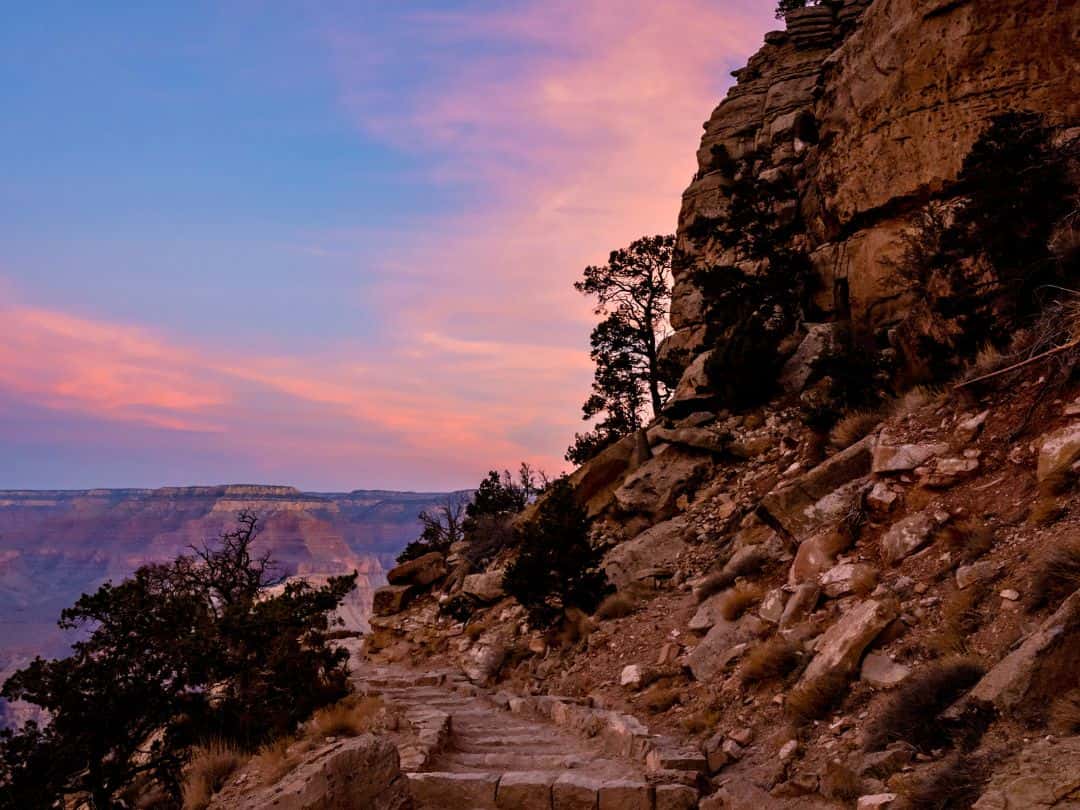
South Kaibab Trail at Sunrise
- Daypack/backpack
You need something you can carry comfortably and has features designed to keep you hiking smartly. Don’t forget the rain cover; some packs come with one built-in. I have an Osprey Daylite Daypack and it is perfect for day hiking.
- Camera!!!
Grand Canyon National Park is a photographer’s dream! If you are like me, you will be taking hundreds, if not thousands, of photos. The scenery is just breathtaking and constantly changing. I have a Nikon COOLPIX P1000 Super Telephoto Camera that I bought a couple of years ago and I like it.
- A spare battery for the camera
Make sure to have a spare battery for your camera. I think there is nothing more frustrating than knowing that you still have half a day ahead of you, yet your camera’s battery is gone.
- Tripod
If you are taking photos during the golden hour (shortly after sunrise or before sunset) when the light is softer, a tripod is essential for long exposure shots. Also, I like a tripod since it gives me more stability when taking close-ups of wildlife. I have a Manfrotto Befree Live Carbon Fiber Tripod with Fluid Head. It is only 3.0 pounds and it fits nicely in my backpack.
- Binoculars!
If your camera does not have a good zoom, then binoculars are a must. I know that luck will be on your side and you will see some wildlife, and what to treat to see them up close.
- Trash Bag
This will make sure that the trail will stay beautiful for generations to come. A zip-lock bag is a great option as well for keeping the trash you pick up along the trail separate from the rest of your gear.
Intrepid Scout's Hiking Tips for an Enjoyable Grand Canyon Adventure
- Stay Hydrated: In the arid Grand Canyon climate, hydration is paramount. Carry an ample supply of water and consider eco-friendly options like a hydration system or a reusable water bottle to minimize waste.
- Pack Thoughtfully: Be discerning about what you stow in your backpack. Essentials such as sunscreen, a wide-brimmed hat, sunglasses, and moisture-wicking clothing are indispensable for a comfortable hike.
- Trail Etiquette: Show respect for fellow hikers and the pristine environment. Yield the trail to uphill hikers, and practice “leave no trace” principles by packing out all trash and litter to keep the canyon unspoiled.
- Early Start: To avoid the midday heat, commence your hike in the early morning. Not only will you relish cooler temperatures, but you’ll also enhance your chances of securing parking at the trailhead.
- Know Your Limits: While the Grand Canyon’s beauty is captivating, its challenges are real. Recognize your physical boundaries and plan your hike accordingly. It’s perfectly acceptable to turn back if necessary—prioritize safety above all.
- Permits and Reservations: If your itinerary includes overnight camping or specific destinations, ensure you check for permit requirements and make reservations well in advance to avoid disappointment.
- Wildlife Respect: Admire the canyon’s wildlife from a respectful distance and refrain from feeding them. Human food can harm animals and disrupt their natural behaviors.
- Photography: Capture unforgettable moments, but remember to immerse yourself fully in the experience without relying solely on your camera lens. Some of the most cherished memories occur in the present moment.
- Leave No Trace: Depart the Grand Canyon as pristine as you found it. Adhere to Leave No Trace principles to minimize your ecological footprint in this delicate ecosystem.
- Embrace the Journey: Lastly, remember that hiking in the Grand Canyon is not merely about reaching your destination; it’s about savoring the journey itself. Take your time, relish the breathtaking vistas, and cherish every step of your adventure. The memories you create will be enduring treasures.
Wishing you all an incredible and safe experience as you explore the South Kaibab Trail and the wonders of the Grand Canyon!
More Information About Grand Canyon National Park:
9 Best Photography Locations in Grand Canyon (+Useful Photo Tips)
14 Useful Tips for First Visit to Grand Canyon National Park
Grand Canyon Shuttle Bus Guide (Maps+Routes+Schedules
Amazing ONE DAY in GRAND CANYON Itinerary (4 Cool Things You Can’t Miss)
10 Best VIEWPOINTS in GRAND CANYON National Park
You Might Also Like:
20 Practical ANTELOPE CANYON TIPS for First Visit (IMPORTANT: Read Before Going)
Lower vs Upper Antelope Canyon (Which One Is Voted the Best)
Visit More National Parks:
Now, It Is Your Turn, I Would Like to Hear Back from You!
Are you planning your trip to Grand Canyon National Park?
Please let me know! Drop me a quick comment right below!
Click on any of the images below to get inspired and to help you with the planning process for your trip to Grand Canyon National Park!
